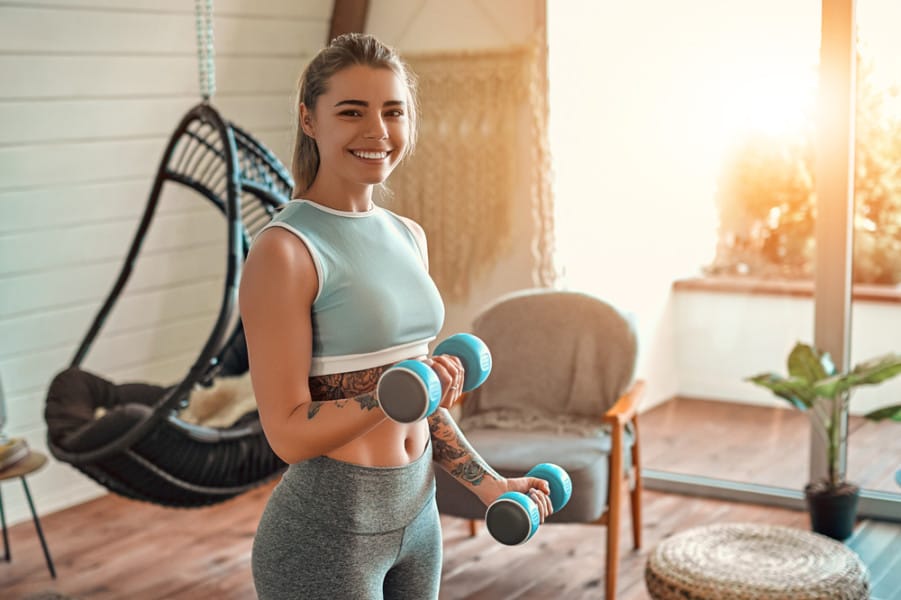Dumbbells: Secretly Engaging More Muscles Than You Think
I don’t know about you, but sometimes doing bodyweight exercises like squats or lunges, it feels like I can go on forever. This is decidedly not actually the case, as anyone who has felt the burn in a long segment can attest. But I’ve found that if I add even a little bit of weight to these moves, like in an at-home full-body dumbbell workout, my ability to keep on going gets diminished so much faster. How can a dumbbell change the game so much?
Because adding in an external load—of any amount of weight—challenges your whole body in a way that holding just your own weight does not.
How dumbbells strengthen your whole body
Progressive weight training, or gradually adding more weight, is the tried-and-true method to build muscle on whatever body part you’re targeting. You can turn to a machine, barbells, kettlebells, or other tools for this end, but dumbbells are a great option if you want a multi-faceted workout.
When we think of dumbbells, we might immediately picture bicep curls, but these classic weights are a tool that can do so much more than that. “Using free weights allows you to work various muscle groups,” Vince Sant, lead trainer and co-founder of fitness platform V Shred, previously told Well+Good about when to use weight machines vs. free weights. Dumbbells can challenge your whole body, even beyond the muscle group you’re actively trying to work, by “strengthening stabilizer muscles,” Sant says. “This also helps strengthen your body overall, even if you don’t realize it.”
So adding weights to a bodyweight move that you think might just be working, say, your quads and glutes (like a squat) actually challenges the small muscles supporting your joints (including your spine) throughout your body. That’s because the weights are threatening to throw your typical center of gravity off balance, and it’s up to your body to keep yourself stable while also doing the targeted muscle move.
Finally, dumbbells allow you to put together compound movements, like a squat with a press, which transform an isolated exercise into a full body exertion.
“There are a lot of benefits of doing compound movements, such as working more than one muscle at a time,” trainer Andrea Somer previously told Well+Good. “Compound movements improve how all the muscles in the body work together to produce and control force and stability. They also involve more muscle tissue and require more oxygen.”
Common mistakes people make when using dumbbells at home
The freedom that a free weight workout provides is both the blessing and the curse, because there is room for more mistakes. The biggest pitfall is not using good form.
“One thing to look out for with free weights is a higher risk of injury due to having to control your own form,” says Sant. Machines often provide support via a bench or backrest. Since the free weight requires on you to maintain your own balance (back to those stabilizer muscles), not engaging your core or swaying your back to shift the load are common mistakes.
You also want to make sure you’re picking the right weight. If a weight is too heavy, you will fatigue before the end of the set, and you’ll likely compensate for the struggle by sacrificing your form. The benchmark for the correct weight is that the last few reps of your set should be challenging, but not to the extent that you have to sacrifice that form. Here’s what to look for if you think you need to go up in weights, according to what personal trainer Bianca Vesco told Well+Good:
- You can get through all of your reps pretty easily.
- You’ve been using the same weights for months.
- You have no problem zoning out during your sets.
- You’re never sore or fatigued.
Try our at-home full-body dumbbell workout
Another big perk of dumbbells is that you can use them for a workout in your own personal space. The key to making a dumbbell sweat sesh a full body workout is making it balanced, meaning you work multiple major muscle groups, and incorporate different types of motions, such as pulling or pulling, pressing or pushing.
Want to give it a go? This workout from trainer Sara DeBerry for Well+Good’s Trainer of the Month Club delivers a conditioning session for your lower body, upper body, and core in just 20 minutes. A dynamic warm-up has you practicing the moves that you’ll do with dumbbells in the working sets, which allows you to activate your muscles to make the most of the exercise. The meat of the video is two working blocks, which each have two sets of three moves. The first is front-racked squats, curls into Arnold presses, and finally the bodyweight core move, the bear crawl. The second contains deadlifts with an alternating reverse lunge, plank rows with a push-up, and then a core/cardio burst with a broad jump, shuffle back into mountain climbers.
If you’re ready to challenge your whole bod with the help of some dumbbell friends, remember to select a weight that will allow you to sustain 45 seconds sets while maintaining good form, and get after it.














